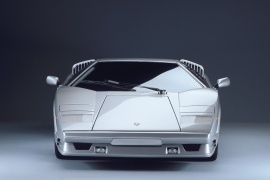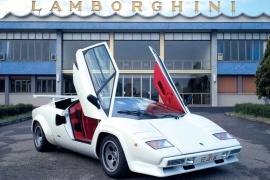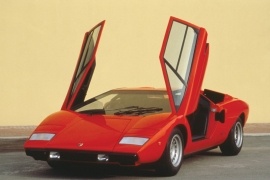LAMBORGHINI Countach Models/Series Timeline, Specifications & Photos
First production year: 1973
Engines: Gasoline
Body style: Coupé (two-door)
It was the car which decorated most boys wall bedroom in the '90s. The Lamborghini Countach was one of the longest production supercars.
The 25th Anniversary edition was one of the most insane Countach ever made. Despite being designed a quarter-century in the back by Marcelo Gandini while he was working for Bertone. Over time, the car was constantly upgraded until the outrageous looking anniversary version.
Unlike the original version, the 1989 model featured a flamboyant aerodynamic package designed by Horacio Pagani. The huge wing in the back and the vents on the engine cover plus the front apron were part of the excessive styling of the Countach.
Inside, the Italian supercar was luxurious by the materials used, but very strange from the comfort point of view. The cramped seats, the tall center console, and the square-looking dashboard and the almost non-existent rear windscreen were all part of the Countach heritage. The side windows were split into three, and only half of the lower one could have been opened. Unlike most of the mid-engine supercars, the Countach featured a trunk between the engine bay and the rear panel. It was large enough to fit airline-size suitcases. In the front, under a small hood, there was the spare-wheel.
The Countach featured a centrally mounted V12 engine fed by 6 carburetors. It was mated to a dog-leg 5-speed manual gearbox. There was no power steering and that made the car difficult to drive. It featured a very unique size tires, fitted on small, 15' light-alloy wheels. Back in the '70s, when the car started its career, those were regular wheels.
After more than a decade after its launch, the Countach was already a legend among supercars. Still, it started to show its age, but the Italian carmaker wasn't ready to pull the plug.
When Lamborghini introduced the Countach in 1974, it was the most stunning appearance on the streets. But by 1985, Ferrari and Porsche started to increase the performance of their models. Moreover, the design trends began to shift from wedged-edges shapes to more curved ones. But the Sant'Agata Bolognese carmaker wasn't ready to make a new vehicle. So it launched the 5000 Quattrovalvole (Four-valves) version in 1985, two years before being bought by Chrysler Corporation.
By 1985, the car had already undergone a few design updates, but the overall look was still angular. The main difference between the 5000 QV and its predecessors was at the back, where the engine's lid featured a bump that lowered the rear visibility for the driver even further. In addition, the wider wheel arches made room for beefier tires, and a wing adorned the back end.
Inside, it was the same cramped Countach as before. Its high seatback sport seats were leather-wrapped, and so were the center console and the door cards. Unfortunately, only the lower part of its side windows could have been lowered due to the unusual shape of the doors.
The engine received new cylinder heads with dual overhead camshafts (DOHC) and four valves per cylinder. In addition, Lamborghini offered the 5000 QV with carburetors or a Bosch fuel-injection system. Strangely though, the carbureted version provided more power than the much more modern fueling system, even though it was less fuel-efficient.
LAMBORGHINI Countach 5000 Quattro Valvole 5.2 V12 5MT (455 HP)
The Countach was the car that put Lamborghini on the map of exotic supersport vehicles, and it was the classic dorm-boy poster all over the world.
After trying different recipes, Ferrucio Lamborghini employed Bertone Studios to design a mid-engined supercar, and that was the Countach, which the Italian carmaker unveiled in 1974. It was the cleanest from the entire 25 years history of this model and the longest production supercar in the world.
Marcello Ghandini designed the car when he worked for the Bertone Studios, and it was based on the prototype Lancia Stratos Zero, which the coachbuilder showcased in 1970. But Lancia didn't want that, and Lamborghini grabbed it. Its wedge-shaped and the unique angled cut for the rear wheels transformed it overnight into a status vehicle. The LP400 was the first released by Lamborghini and didn't feature any flared arches or flamboyant wings in the back. Its clean design with flat panels and angular shapes was unmistakable.
Inside, it was cramped even for two people. Lamborghini was not at its first car or first mid-engined vehicle, but this one was the first that featured a longitudinal, mid-mounted V-12 engine. Its predecessor, the Miura, featured a transverse-mounted V-12. With that little cabin room left, Ghandini managed to squeeze a pair of sport bucket seats. To ease the ingress and egress, he invented the unique door opening system. The rectangular instrument cluster hosted eight gauges and dials. On the center stack, there were another two just to complete the information. Since the car was costly, Lamborghini tried to provide more features, including leather seats and an AC unit.
Under the hood, it was the same engine as on the Miura P400 but installed longitudinally. Lamborghini paired it with a five-speed manual gearbox.


